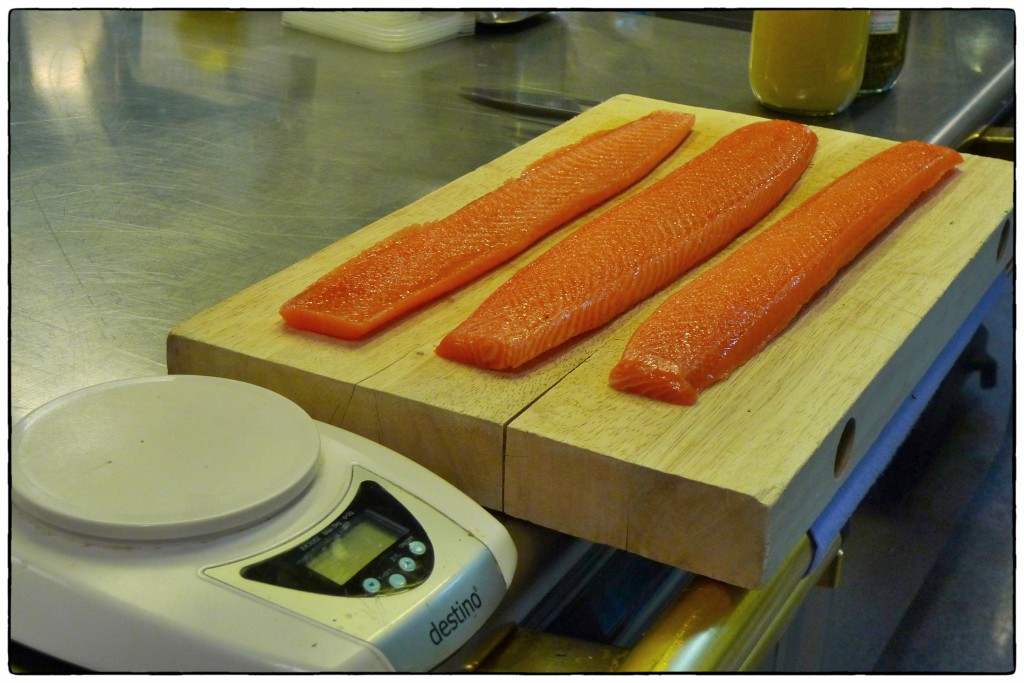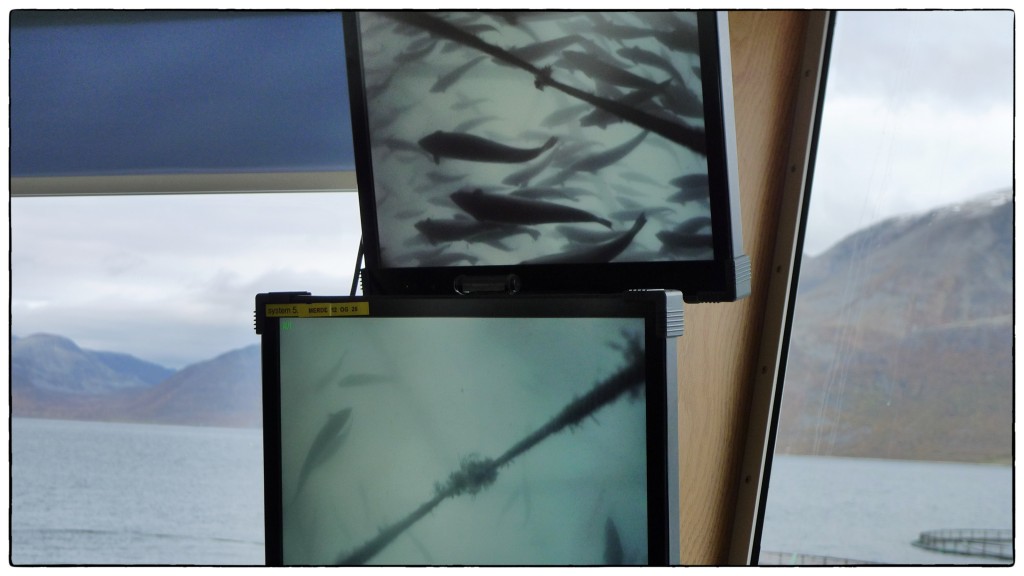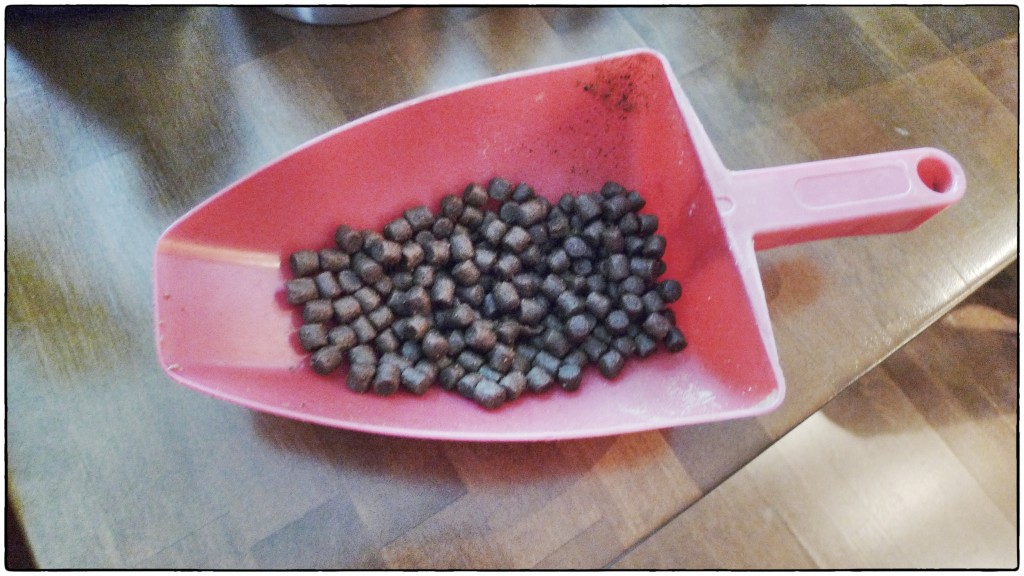So, I did it.
The dyed-in-the-wool locavore, organic-head, greenmeister, hater-of-all-things-mass-produced, factory farm-loathing, Big Agra-hating, Alice Waters-loving, Wendell Berry-quoting, EAT MORE KALE tee shirt-wearing, Oceana-supporting, cliche-on-two-legs typing these words just got back from an excursion with author, NYU Professor of Nutrition, Food Studies, and Public Health, Marion Nestle, chef/activist Peter Hoffman, journalist Kate Rockwood, and clinical nutritionist Stella Metsovas to northernmost Norway to visit a salmon farm, courtesy of The Norwegian Seafood Council. It was a very, very big salmon farm. The kind of salmon farm that, across twelve “pens” located off the coast of Skjervoy, “grows” millions of salmon a year; the Aurora Salmon “processing plant,” which we also visited (and where you could have eaten off the floor, it was that clean), puts out the equivalent of one million meals. Per day.
I would like very much to say that my trip confirmed what I, in my heart, already know. I would like very much to say that what I, in my heart, already know is also unimpeachably accurate. I would very much like to say that when I stand at my local fish market counter and shell out $29.99 a pound for wild salmon, that it has been caught and processed ethically (and is far easier on the environment compared to farmed fish, in ways too numerous to mention here), and so the decision between eating it or its farmed cousin from Norway is a no-brainer.
But I can’t; it’s not so easy.
When I go shopping for salmon, my decision will continue to be fraught, and mired in the memory of a remarkable day spent on a salmon barge in the Arctic Ocean, watching exactly how the strictly regulated Norwegian salmon farming industry works, in practice (at least at this particular farm): the fish are in pens that are 160 meters (524 feet) in diameter, and 300 feet deep, to the sea floor. Each pen is 97.5% water and 2.5% fish. Each pen, once it has been harvested, is released from use for 2-1/2 years, which supposedly prevents dead zones. The water is tested regularly for pathogens, and the fish — like hogs and cattle — vaccinated to prevent illness (we were all aghast at this fact. How do you vaccinate a fish? You anesthetize it first. With anesthesia. The image of a salmon counting backwards from ten with a tiny little mask over its gills like a pair of Bose headphones sticks in my craw). The fish are fed feed that looks, as Marion described it, like dog food. I bit into one pellet: it was fishy and oily because, according to information provided to us during a presentation by NIFES (National Institute of Nutrition and Seafood Research, based in Bergen) it contains a combination of rapeseed oil, soy oil, corn oil, linseed oil, and fish meal, which you need if you want a farmed fish that actually tastes like fish. Where does the fish meal come from? From wild fish, which, of course, pretty much kills the argument that farmed fish is the answer to the depletion and overfishing of our oceans. But that’s beside the point.
The processing plant was the cleanest factory I’ve ever seen, of any kind; in their “holding” pens, the fish looked happy. Not like The Incredible Mr. Limpet happy, but at least not apparently worried, or stressed. Their eyes were clear, which is what my paternal grandmother, who evidently knew fish, always said was how you judged if one was healthy or not. Of course, I’ll never know for sure if the fish I was looking at were calm and collected. And the fish we tasted — produced primarily for the high-end sushi and sashimi market in Japan — was extraordinarily delicate, mild in flavor, and exceptionally fatty, having lived its life on a diet of assorted oils. It was a gorgeous salmony pink color which, sadly, comes from the dye in its meal. (Bear in mind: this is very, very pricey farmed salmon. The stuff that you get at big box stores — we all know who they are — doesn’t even come close to it, qualitatively.)
So the plant was clean and the workers, happy. The fish were gorgeous, and their pens — which are outfitted with cameras that shoot from the bottom up so that their food intake and conditions can be closely monitored — were apparently the fishy equivalent of the presidential suite at the Hassler. By comparison, Marion spoke of a trip she once took to Alaska paid for by the Alaskan Seafood Marketing Institute, where she witnessed everything from deplorable labor conditions to system waste to extended “holding” which impacts the fish’s freshness (and presumably, safety).
The salmon she was in Alaska to learn about was wild.
On the face of it — and assuming that what we saw is representative of all Norwegian salmon farms — the Norwegian farmed salmon industry is a very tightly run ship that results in an exemplary culinary product; they are proud of what they do, and rightly so.
So what was my sticking point? What can’t I get beyond, no matter how hard I try? The feed.
Rapeseed oil, which is derived from the same plant as Canola, is almost always genetically modified, and certainly would be, one could assume, when utilized in feed produced on such a massive industrial scale. Add to it corn oil, linseed oil, and soy oil, and you’ve got what sounds to me like a GMO shopping list underwritten by Monsanto.
During our initial meeting in Tromso with NIFES, I asked who, exactly, determines and regulates what goes in to the feed.
“The EU,” they answered, making the fact that Norway is not a member of the EU nor are the farms in international waters that much more disconcerting. “But it’s not scientific,” they added.
I’m sure not.
Without getting into issues of inefficiencies and longterm sustainability in wild fishing, and the problems surrounding escapes in fish farming and the overall impact of GMOs in feed across the board, the question I came away with is this: Is it always more ethical, more environmentally appropriate, and just plain healthier to eat wild salmon that’s been processed in squalor by Filipino women on 14 hour shifts … just because it’s wild and theoretically, environmentally, and morally superior? Is it more ethical, more environmentally appropriate, and just plain healthier to eat farmed salmon produced in a state-of-the-art facility by expert workers in “ideal” factory conditions, where the fish are kept in as healthful a state as they can possibly be, in water that’s crystal clear, but whose diet is manipulated with probable GMO oils in order to effect a more Omega 3-laden (and ostensibly healthier) product outcome?
Some years ago, I attended a discussion in New York, where one of the panelists was asked a pointed question about organics always being preferable to conventionally-produced food. I expected a simple answer: yes.
The answer was It depends.
Are we talking about the industrial Cal-Organic? Or your local farmer’s market? Are we talking about gorgeous organic oranges that have arrived from overseas, where regulations about what can be called organic are not quite up to snuff? Or are we talking about a luscious, high-end, organic chocolate bar produced by child laborers on the Ivory Coast?
The answer is as murky as the deepest sea; all we can do is know our food, know our fish, know the quality of the environment it lives and dies in, what it eats, how it is processed and by whom, and in what conditions. Is this realistic? Can we ask this much of the average consumer on a supermarket line after a miserable day at the office? I don’t know.
And it’s why I’ll continue to stand at my local fish counter, staring at the words ORGANIC and WILD and FARMED, looking for the truth, and pondering which way to go.








Marion’s trip to Alaska sounds hideous. I’m glad my own visit (to the Copper River, thanks to Trident Seafoods) was not remotely like hers. More than anything, this story makes me glad that I can know my fishermen as well as I know my farmers.
And that, my friend, is the point.
I stand at the counter too, and sometimes this is the dilemma. The wild is so much more expensive than the farmed that it doesn’t move and doesn’t look fresh. In that case (except for once when I was cooking for a friend who wanted salmon), I just walk away. Salmon is never on my menu plan. We eat it when I find some that works.
I’m wondering about the potential toxicity of the dyes, which presumably are made from synthetic chemicals. Did they address that?
Last year I was lucky enough to hook up with a local native American woman who brought back whole salmon from the coast, caught that morning, and got two of them. They were wonderful.
But when that ran out, as it inevitably did I went with the wild stuff from the grocery store. I tend to doubt that most farmed stuff originates from such a stellar environment as you witnessed.
I guess I’m not an “average” consumer inasmuch as I can pretty well buy whatever I want. But I go with organic, in season, local (at least grown in the US, which hopefully means here in California) and hope for the best. Which for me means, best for my family’s health, and the minimum amount of damage to the planet.
The real problem we face is 7 billion people, most especially the first world component. But it’s not polite to point that out, is it?
Great and enlightening post. I feel like this is the whole point of good/ethical/healthy/enjoyable eating. We’re often faced with shades of grey and therefore have to try to strike a balance. So many times I stand in the supermarket checking ingredients, weighing up the choices ( not necessarily in this order), fun factor, taste factor, health factor, origin factor, organic factor, price factor.. and it goes on. I am British but live in France so, like Jill, I can buy fish caught by local pecheurs. To be honest the French market culture probably answers a lot of these questions…
Actually, they said that the dye came, in part, from the fish meal (which contains krill).
This is such a precise illustration of why every single choice at the fish market (or the meat market, for that matter) feels fraught. We live in the San Francisco area, so there are ‘local’ fisherman and some farmer’s market mongers that sell ‘local’ fish – but dig a little deeper and it seems like there is so often something a little fishy (sorry). I am repulsed by the idea of fish farming – and yet the pristine waters you describe sound so preferable to unsavory ‘wild’ fishing operations – and how are we really to know what we are getting, if we don’t know the fisherperson? And why is it that fish gets exempted from the whole ‘eat local’ movement so regularly, anyway? … Annie’s point about 7 million people is interesting, too. There is always that line we walk between what is healthy for our own (I want my kids to eat fish for health and personal enjoyment) and what is healthy for the world (maybe they really shouldn’t eat fish for environmental and ethical reasons). Thank you so much for this insightful and thought-provoking post, and for raising the bar on the discussion of farmed vs wild …
* 7 billion people, sorry Annie
What an honest and insightful piece into the decisions we make as responsible people and, more specifically, responsible eaters. I agree that it really comes down to “it depends” — which means we have to be conscious about our decisions as often as we can. Can I be responsible about my purchases every time I go to the market or the grocery store? I hope so — but then again, it depends.
Great post-love the cliche on two legs bit! Nice to see how it’s done, but again points out to me that it’s all so unsustainable. The privilege of being in the cliche on two legs class, is that you have a choice. Fish is sad thing. More sustainable and healthier to eat deer (in PA anyways) or if you must grow more cow chicken and hogs in nicer ways.
Thank you Will–
I found your wonderful blog through a link from Tamar’s blog. I think I’m going to have an extra cup of chaga tea and read lots more.
For fairness and full disclosure, I’m surrounded by lakes and am able wild harvest as much fish as we want to eat, and have easy access to ocean fish via my lobstermen brother-in-law, nephew and other family members. Fresh, healthy fish that lived a natural life is very easy for me. I live near salmon pens and am familiar with how they’re operated. I like only fresh water salmon, and my husband loves all kinds of salmon. We do buy farmed salmon two or three times a year.
Vaccinating fish feels like feeding antibiotics to livestock to keep them healthy instead of raising them well. Fish don’t naturally eat soy, canola, corn, etc. Dyed food to give the fish color… all so unnatural.
The price looks less expensive on the sign in the store but we’re subsidizing the crops grown for their unnatural food with tax dollars. If you add those tax dollars to the cost per pound it evens out a bit more. Add in the cost of the damage caused by the way those crops are grown and it’s getting closer. Cost isn’t fully measured at the check out.
Modern times and technologies have made food much more complicated than it ever should be.
Perhaps if you knew more about genetically modified crops and the possibilities of technology you would also have a “shade of gray” moment. Funny how we accept biotechnology when it shows promise in medicine and disease eradication, but go all black when applied to our foods. Absolute beliefs are absolute nonsense.
Too bad that belief trumps facts every time.
Thanks for writing this. You’ve certainly spared me trip to a high end salmon farm.
I find eating fish far harder than eating meat, for all of the above reasons.
My favourite fish sign was outside Whole Foods on East Houston a while back. It fairly crowed,”Wild Caught Swordfish!”
(…Shopper pauses, thinking…)
God almighty, what a find you are. A fabulous writer, passionate about food and altogether kick-ass. This day has its blessings. I am looking forward to many rewarding visits here. Many thanks to you.
From the land of the starved, Valerie
! !
U
Valerie- what a lovely note. Thank you so very much. Hope you continue to enjoy. -E.
a wee gift
http://pinterest.com/pin/129760032984894165/
Elissa,
This post also speaks to the unreasonableness of our propensity to “package” everything neatly. I currently work for a sustainable agriculture research initiative and we find as you did at the salmon farm, there is no one-size-fits all-solution to producing (or labeling) food, especially in the developing world where issues of gender equity and climate change are important factors. My office actually responded indirectly to Mark Bittman’s recent piece about a “simple solution” to farming. Our response was basically, it’s not so simple. More particularly regarding farmed fish, have you seen the Austrian film “Our Daily Bread”? The filmmaker captures some truly horrifying footage of factory farmed fish. Thank you for keeping the food system debate lively!
Great post.
Very interesting. The best choice may be the hardest one: abstain from eating salmon. If you’ve had ethiopian or indian food lately you know that lentils and garbanzos can just as delicious as smoked salmon! And cheaper, healthful, and free from moral dilemmas
{ 1 trackback }